Get our independent lab tests, expert reviews and honest advice.
Added vegetables in processed foods

Getting kids to eat their vegies: it’s a battle as old as time itself. While dietary guidelines recommend at least five servings of vegetables a day for most age groups, convincing your child to have just a forkful of peas or a single broccoli floret can require a masterclass in manipulation.
And it’s not just children. The most recent national nutrition survey found that less than four percent of the population – and less than one percent of children – regularly eat the minimum recommended number of servings of vegetables and legumes/beans.
During your trips to the supermarket, you’ve probably noticed a number of food companies leveraging this issue, making claims on the label about the number of vegie serves in their products. Everything from chips to chicken nuggets seems to be fair game. If it’s an uphill challenge getting your kids to eat more vegies, these products hold obvious appeal. So can these foods really make a meaningful contribution to their five-a-day?
All talk and no substance
On the surface, the claims sound promising. Six serves of veg in a pasta sauce – bring it on! But a closer look reveals that many of these claims are little more than marketing puffery.
For example:
- A standard serve of vegies is 75g, but food companies sometimes use creative accounting when converting the amount of veg in their products to a number of serves on the label.
- The claims tend to reference the whole pack/bottle/tin, but realistically you’d only be eating a portion of it at any one time.
Also, more often than not the ‘veg’ in question is tomato (closely followed by carrot, then onion). Now, there’s nothing wrong with tomatoes – in fact, they’re incredibly nutritious and versatile (and for the purpose of this article, we won’t quibble about their categorisation as veg rather than fruit).
Many of these claims are little more than marketing puffery
But the recommendation to enjoy plenty of vegetables in your diet is as much about including different types and colours of vegetables as it is about eating big enough servings. So you can’t rely on these packaged foods to provide this diversity.
To make matters worse, the ‘serves of veg’ claims are often on the labels of highly processed food. So along with the (often scant) vegies, you tend to be getting less desirable ingredients too, such as salt and added sugar.
Here are some examples.
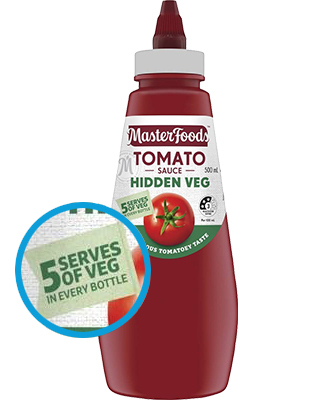
Masterfoods Tomato Sauce Hidden Veg
Pack claim: “5 serves of veg in every bottle”
Masterfoods isn’t the first to hide vegies in food – parents worldwide have been hiding vegies in their kids’ meals since the dawn of time. The ‘hidden veg’ in this sauce includes carrot and sweet potato, as well as the ubiquitous tomato.
But each 15mL serve (about three teaspoons) of sauce contains just 12g – or 0.2 of a serve – of vegies. So unless you’re adding liberal quantities of sauce to everything from sausages to salad, you’ll barely scratch the surface of the five-a-day target.
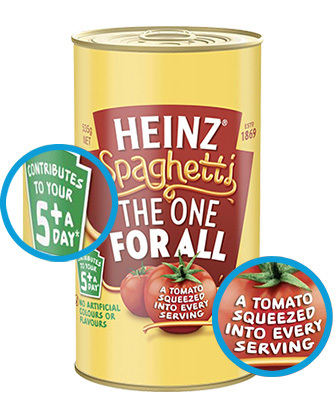
Heinz Spaghetti The One For All
Pack claim: “A tomato squeezed into every serving. Contributes to your 5+ a day*” (“*Contains 3 serves of vegetables per can”)
Three serves of vegetables – that’s only two away from your daily target. That said, it’s three serves of tomatoes, which isn’t exactly the wide variety of veg you should be aiming for.
Plus, the can is meant to feed four, so if you eat just one portion, you’re getting only 58g (0.8 of a serve) of veg. Eat the whole can, and you’ve had 1605mg sodium, which isn’t far off twice the 920mg you need in a day. Not an ideal outcome if what you’re actually trying to do is eat more vegies.
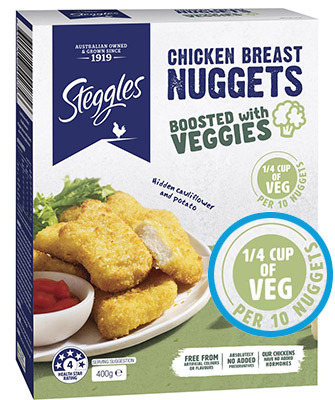
Steggles Chicken Breast Nuggets Boosted with Veggies
Pack claim: “Boosted with veggies.” “1/4 cup of veg per 10 nuggets.” “Hidden cauliflower and potato.”
This product sounds like a win-win. Nuggets to keep the children happy, with hidden veg to keep their parents happy. That ¼ cup of veg in every 10 nuggets may seem impressive, but when you check the ingredients list it’s actually just 14g in a 100g serve of nuggets – 0.2 of a 75g serving of vegetables.
Anyone who could stomach that quantity would be getting double the sodium and more than half the kilojoules that the average adult needs or consumes in a day
That means you’d need to eat the entire 400g pack of nuggets plus a portion of a second pack to get a whole serving of vegies. And anyone who could stomach that quantity would be getting double the sodium and more than half the kilojoules that the average adult needs or consumes in a day.
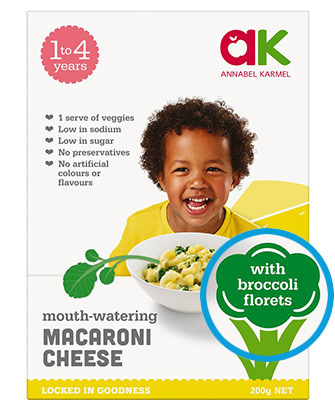
Annabel Karmel Macaroni Cheese
Pack claim: “1 serve of veggies”
Mac ‘n’ cheese, another surefire hit with children, with bonus broccoli. This single-serve 200g product contains 20% broccoli, which by our calculations equals just 40g – somewhat short of a 75g serve.
Sure, the recommended number of serves of veg for the age group this product is marketed to is half that of adults, but it’s still not the “1 serve of veggies” it promises on the pack.
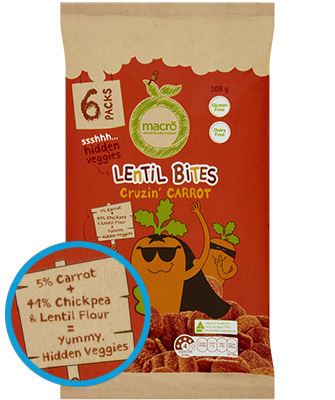
Macro Lentil Bites Cruzin Carrot
Pack claim: “5% Carrot + 41% Chickpea & Lentil Flour = Yummy, Hidden Veggies”
On the face of it, 46% veg (5% Carrot + 41% Chickpea & Lentil Flour) sounds pretty reasonable.
But these puffed-up snacks are actually so lightweight that an individual pack weighs just 18g, which means that 46% is a paltry 8g – about 0.1 of a standard serve of vegies.
Perhaps that’s what they mean by “hidden”.
10 ways to help reach five serves a day
Processed foods with added vegies may have more nutritional benefit than comparable processed foods without, but they’re no match for actual vegies when it comes to making a dent in your five-a-day target. Nor do they encourage the healthiest of eating habits, which is particularly important for children.
Nutrition aside, the added bonus of buying fresh or minimally processed vegetables is you get more bang for your buck, particularly if you’re buying in season. The trick is getting your kids to eat them.
So we turned to nutritionists – and CHOICE parents – for inspiration. Here are their top tips:
- Encourage children to help shop for and choose vegetables, as well as helping with their preparation – e.g. shredding lettuce, grating carrots and packing vegie sticks in school lunchboxes.
- Offer vegies throughout the day and start early. Trying to get your kids to eat five serves in their evening meal can be tricky, if not impossible.
- If they’re vegie-averse, “hide” lentils in their bolognese sauce, cauliflower in their mashed potato and grated carrot, pumpkin or zucchini in their scones and banana bread, and foods such as meatloaf and rissoles.
- Keep offering your children vegetables, even if they reject them at first.
- Add extra diced vegetables to kid-friendly foods such as fried rice and frittata, and increase the amount of vegetable toppings on their homemade pizzas.
- Let kids serve themselves at the table, choosing what and how much they want. This works well for dishes such as Vietnamese rice paper rolls, Mexican fajitas and Korean barbecue lettuce wraps.
- Eat your vegie-filled evening meal together at the dinner table. Vegetables have traditionally been eaten mainly at dinner in Australia, and with many families no longer having a family meal, the vegetables have become casualties.
- Try a tasting-plate approach with your children, offering them a few favourite veg, alongside some less familiar options. Examples include celery sticks, capsicum strips, cherry tomatoes, edamame beans, whole button mushrooms, carrot (sticks or grated), snow peas, beans, olives, cucumber or steamed asparagus. Pair these with vegetable or pulse-based dips such as hummus.
- Help your kids grow their own vegetable garden. If you’re in a flat or have limited space, sprouts, herbs, lettuce and cherry tomatoes are easy to grow in pots on a window sill or balcony.
- Set a good example yourself. Regularly tuck into and be seen to enjoy vegetables and salads in front of your kids.






